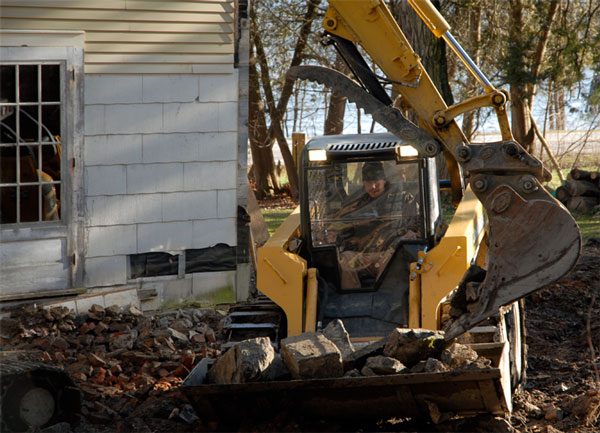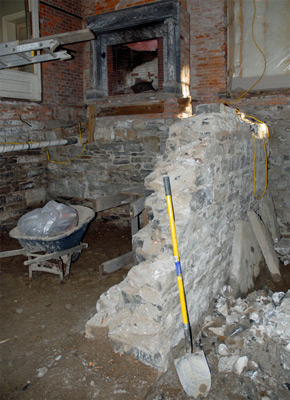
“I look at it as an excavation, if you will,” says the architect. (New England Home)
The architect, Pete Lackey of Charles Myer and Partners in Cambridge, Massachusetts, is referring to “taking the long view” on renovation, specifically to reawakening the heart and soul of a building instead of willfully or inadvertently altering it.
I wanted to touch and smell and hear Rosslyn in order to understand her… I wanted to ensure that we wouldn’t impose our own will haphazardly onto those of the house… I considered it arrogant to impose our dreams upon Rosslyn without first trying to understand her dreams. I wanted to listen to the old house, to hear what she was trying to tell us. (Reawakening Rosslyn)
In our case, understanding Rosslyn involved literally and figuratively excavating the historic home. During the fall/winter of 2006 a local excavator began disinterring the western end of the ell (addition) in order to identify and resolve the cause of major water to the house. This project was interrupted by the arrival of snow and resumed in the spring. By then we had seen enough of the subterranean foundation problems to redefine the water remediation scope of work. But the time we resumed excavation in the spring of 2007, the scope of the project had already mushroomed.
Excavating the perimeter of the house revealed generations of alterations and revisions, and it disclosed three distinct underground, gravity fed sources of water entering the basement. All three were originally part of a cistern and rain water collection system most likely dating back to the construction of the house in about 1820. They had been long since abandoned, but the terrra cotta pipes still delivered an endless flow of water into the basement beneath layers of rubble, debris, etc.

The most affected area of the house — the basement beneath our current living room — required hand excavation of thousands of pounds of clay and debris which had collected over two centuries. Three other men and I spent a long weekend working long days with picks, shovels and wheelbarrows to remove the material. Exhausting! And profoundly fulfilling.
In both of these cases the excavation exposed problems and solutions. In many other cases, especially those in which the excavations were less literal, the history and mystery of Rosslyn compounded before clarity or resolution emerged. In many cases, I still have more questions than answers.
Between 1820 and 2006, Rosslyn had been modified and updated and neglected and abbreviated so often that the house had become a puzzle of disconnected parts. We wanted to rediscover Rosslyn’s continuity, her wholeness. By digging through her basement and walls and a vast archive compiled by the previous owner we gradually deciphered most of her mysteries, permitting us to rehabilitate her in a fashion consistent with her heritage.
This quest underlies much of the Rosslyn Redux memoir, and I dabble a bit with the idea of archaeology and — more precisely — the idea of “archaeology of home” to help chronicle this quest. At least as much of my energy went into analyzing artifacts (bricked up window apertures, wallpaper clinging to walls buried behind newer walls, cracking photographs of Rosslyn discovered on eBay, sketches and drawings of original moldings and window details) as it did into hiring and supervising contractors.
It is this journey as much as the renovation story which I hope to communicate in my story, and with a little luck, it won’t take you as long to read it as it took my bride and me to live it… No promises!
What do you think?